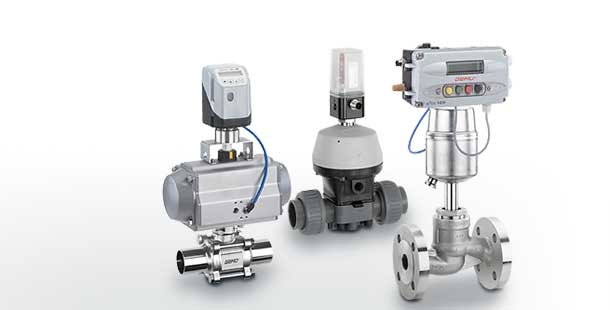Cutting-edge Control Valves: Enhancing Accuracy and Reliability
Cutting-edge Control Valves: Enhancing Accuracy and Reliability
Blog Article

Maximize Power Financial Savings and Comfort With Advanced Structure Automation Controls
In the world of modern architecture and facility monitoring, the assimilation of advanced building automation controls stands as an essential improvement. By harnessing the power of automation, structures can adjust, respond, and progress in methods that were once unbelievable.
Power Efficiency Advantages
Energy effectiveness benefits can dramatically reduce energy usage and operational expenses in structures. Energy-efficient systems, such as advanced building automation controls, can optimize the use of sources like heating, lighting, and air conditioning, leading to lower energy expenditures over time.
Furthermore, boosted power performance can extend the lifespan of structure tools and systems. By operating more efficiently, cooling and heating systems, lighting fixtures, and various other structure elements experience less damage, leading to reduced upkeep and replacement prices. Furthermore, energy-efficient buildings frequently regulate greater residential or commercial property worths and rental prices, offering lasting economic benefits to owners.
Furthermore, energy efficiency can boost occupant comfort and performance. Properly regulated indoor atmospheres with ideal illumination and thermal conditions create an even more helpful and positive workspace, resulting in enhanced employee contentment and performance. Overall, the power effectiveness advantages associated with innovative building automation controls are multifaceted, incorporating expense financial savings, ecological stewardship, and occupant wellness.
Improved Convenience Control
Enhancing comfort control in building atmospheres calls for a sophisticated combination of innovative automation systems for optimum resident health. By using innovative building automation controls, centers can tailor the interior atmosphere to fulfill the details requirements and choices of passengers. These systems enable specific law of temperature, lighting, and ventilation, developing a effective and comfy ambience. Owner complete satisfaction and productivity are closely linked to thermal comfort, making it necessary to have systems in area that can adapt to changing problems in real-time.
Boosted convenience control exceeds basic temperature level modifications. It includes features such as personalized settings, occupancy sensors, and natural light utilization to create a vibrant and responsive setting. By integrating these advanced controls, structures can not only boost comfort however additionally improve power performance by optimizing system operations based upon actual tenancy and usage patterns. Ultimately, prioritizing owner convenience via sophisticated automation systems brings about an extra pleasurable and much healthier indoor environment.
Functional Performance Improvements

Additionally, the execution of real-time monitoring and analytics devices allows building operators to identify energy ineffectiveness and functional anomalies promptly. By continuously keeping track of energy use patterns and system performance metrics, changes can be made in real-time to maximize energy usage and ensure peak operational efficiency. control valves. Additionally, including demand action strategies right into building automation controls can better enhance operational performance by dynamically adjusting power use based upon grid problems and rates signals
Indoor Environment Optimization
Reliable interior climate optimization is an essential element of building automation controls, making certain occupants' comfort and well-being while making the most of power savings. By using sophisticated sensing units and controls, constructing automation systems can constantly keep track of and change temperature level, moisture levels, air top quality, and air flow to develop an optimal indoor atmosphere. Preserving constant and comfy problems not only boosts occupant contentment yet also improves performance and overall well-being.
Interior environment optimization investigate this site additionally plays an essential role in power efficiency. By fine-tuning air conditioning, heating, and ventilation systems based on real-time information and occupancy patterns, constructing automation controls can dramatically decrease power consumption - control valves. For example, applying approaches such as demand-controlled ventilation and thermal zoning can help reduce power waste while making certain that each location of the building gets the needed conditioning.

Sustainable Atmosphere Development
Building automation regulates not only maximize interior environment conditions for energy performance and occupant convenience however also lay the structure for developing a lasting atmosphere with calculated administration of resources and systems. By incorporating innovative building automation modern technologies, such as sensing units, actuators, and best site smart software, centers can check and readjust power use in real-time to decrease waste and lower their carbon footprint. These systems make it possible for predictive maintenance, identifying possible issues before they intensify and enhancing equipment performance to improve long life and effectiveness.
Additionally, lasting environment development extends beyond energy administration to incorporate water preservation, waste decrease, and indoor air quality enhancement. Structure automation controls can manage water usage, identify leaks, and ensure appropriate waste disposal methods, adding to overall sustainability initiatives. Additionally, by keeping an eye on and managing ventilation and filtration systems, these technologies enhance passenger wellness and performance while reducing energy usage related to heating and cooling procedures.
Conclusion
In verdict, advanced building automation manages deal substantial advantages in regards to energy financial savings, convenience control, functional effectiveness, interior climate optimization, and producing a lasting setting. By implementing these controls, structures can accomplish optimum efficiency while decreasing power intake and improving resident comfort. It appears that making use of advanced automation technology is crucial in improving structure efficiency and developing an extra lasting future.
Energy effectiveness advantages can substantially minimize energy usage and functional expenses in structures. Overall, the energy performance advantages associated with sophisticated structure automation controls are multifaceted, including cost financial savings, environmental stewardship, and resident health.
Additionally, including need response approaches right into structure automation controls can better improve operational performance by dynamically changing power usage based on grid problems find out and pricing signals.
Building automation controls not just optimize interior climate conditions for energy efficiency and occupant comfort however also lay the structure for producing a lasting environment via strategic management of sources and systems.In conclusion, advanced building automation regulates offer substantial benefits in terms of energy financial savings, comfort control, operational effectiveness, indoor climate optimization, and producing a lasting atmosphere.
Report this page